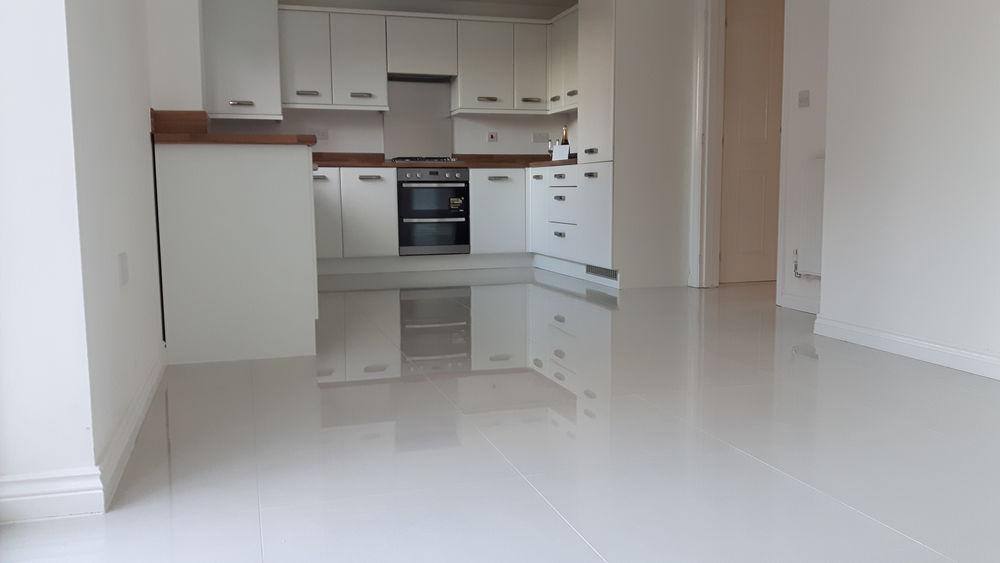
What is Anhydrite Screed?
Anhydrite screed is a gypsum-based alternative to traditional sand and cement screeds. It provides a smooth, level surface, making it ideal for underfloor heating systems.
Advantages of Anhydrite Screeds
✅ Self-leveling – Provides a smooth and even surface.
✅ Fast installation – Can be laid in large areas quickly.
✅ Ideal for underfloor heating – Conducts heat more efficiently than cement screeds.
✅ Lower shrinkage risk – Reduces the chance of cracking.
Challenges of Tiling Over Anhydrite Screed
Unlike cement-based screeds, anhydrite screeds contain calcium sulfate, which reacts negatively with standard cement-based adhesives, leading to tile de-bonding and failure.
Key Challenges & Solutions:
⚠ Surface laitance – A weak, dusty layer forms on top as the screed cures and must be removed (Solution: Grinding/sanding).
⚠ High moisture content – Must be fully dried before tiling (Solution: Moisture testing).
⚠ Adhesion issues – Standard cement-based adhesives won’t bond properly (Solution: Priming & using the right adhesive).
⚠ Movement & cracking risk – Can expand and contract with underfloor heating (Solution: Use a decoupling mat).
Step-by-Step Guide to Tiling Over Anhydrite Screeds
1. Ensure the Screed is Fully Cured & Dried
Moisture is the biggest cause of tile failures over anhydrite screeds. It must be fully dry before tiling.
- Drying time:
- Screed dries at 1mm per day up to 40mm thick.
- For thicknesses above 40mm, it takes 2 days per mm.
- Example:
- 40mm screed = 40 days drying
- 50mm screed = 60 days drying
- 60mm screed = 80 days drying
- Moisture Testing:
- The screed must have less than 0.5% moisture content before tiling.
- Use a hygrometer or a calcium carbide moisture test to confirm dryness.
2. Remove Surface Laitance (Key Step for Bonding)
Anhydrite screeds develop a weak, dusty layer (laitance) as they cure, which must be removed before tiling.
✅ How to remove laitance:
- Mechanically sand/grind the surface using a diamond grinder or rotary sander (60-100 grit).
- Vacuum thoroughly to remove all dust and debris.
3. Apply a Suitable Primer (Essential for Bonding)
Once laitance is removed, prime the surface to seal the screed and improve adhesion.
✅ Recommended Primers:
- Use a calcium sulfate-compatible acrylic or epoxy-based primer (e.g., BAL Prime APD, Mapei Eco Prim T Plus).
- Apply two coats, allowing each to dry fully before tiling.
4. Use the Right Adhesive
❌ Do NOT use standard cement-based adhesives!
✅ Instead, use calcium sulfate-compatible tile adhesives, such as:
- BAL Rapid-Flex One
- Mapei Keraquick S1
💡 If tiling over underfloor heating, use a flexible adhesive to accommodate thermal movement.
5. Using a Decoupling Mat (Recommended for Extra Protection)
A decoupling membrane (e.g., Schluter DITRA Mat or BAL Flexbone) is highly recommended when tiling over anhydrite screeds, especially if:
- The screed has underfloor heating (to absorb thermal expansion/contraction).
- The screed thickness is over 50mm.
- There are concerns about screed movement or cracking.
✅ How to Install a Decoupling Mat:
1️⃣ Prime the screed first (as mentioned in Step 3).
2️⃣ Lay the decoupling mat using an approved adhesive (e.g., BAL Rapid-Flex One).
3️⃣ Ensure full adhesion by pressing it down firmly with a roller.
4️⃣ Tile directly onto the mat using a suitable flexible adhesive.
💡 Benefits of a Decoupling Mat:
- Prevents cracks in the screed from affecting the tiles.
- Allows minor movement without causing tile failure.
- Provides extra durability and peace of mind for long-term performance.
6. Expansion Joints & Underfloor Heating Considerations
- If underfloor heating is present, turn it ON for 2 weeks before tiling to remove any residual moisture, then turn it OFF 48 hours before tiling.
- Install movement joints at doorways and in large tiled areas to allow for expansion.
Why Choose Coventry Tiling for Anhydrite Screed Tiling?
At Coventry Tiling, we specialize in tiling over anhydrite screeds, ensuring a flawless, long-lasting finish.
Why Work With Us?
✅ Expert Preparation – We remove laitance, test moisture, and use the correct primers & adhesives.
✅ Decoupling Mat Installation – We recommend and install DITRA Mat or BAL Flexbone where needed.
✅ Specialists in Underfloor Heating Tiling – Preventing movement issues and ensuring a stable tile finish.
✅ Professional & Reliable – Quality workmanship with a guarantee for peace of mind.
Get a Free Quote Today!
If you need professional tiling over anhydrite screeds, we’re here to help! Contact Coventry Tiling today for expert advice and a flawless finish.
Serving Coventry, Warwickshire, and surrounding areas.